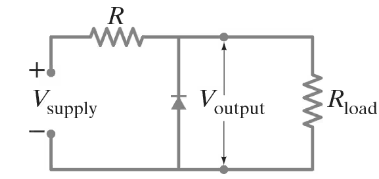 Back
BackProblem 54
(II) An ac voltage of 120 V rms is to be rectified. Estimate very roughly the average current in the output resistor R (42 kΩ) for (a) a half-wave rectifier (Fig. 40–39), and (b) a full-wave rectifier (Fig. 40–40) without capacitor.
Problem 59
(III) A 120-V rms 60-Hz voltage is to be rectified with a full-wave rectifier as in Fig. 40–40, where R = 24 kΩ, and C = 35 μF. (a) Make a rough estimate of the average current. (b) What happens if C = 0.10 μF? [Hint: See Section 26–5.]
Problem 61
If the current gain of the transistor amplifier in Fig. 40–49 is β = ic/iB = 95, what value must Rc have if a 1.0-μA ac base current is to produce an ac output voltage of 0.40 V?
Problem 65
(II) From Fig. 40–49, write an equation for the relationship between the base current (IB), the collector current (Ic), and the emitter current (IE), not labeled in Fig. 40–49). Assume the ac current iB = iC = 0.
Problem 72a
One possible form for the potential energy (U) of a diatomic molecule (Fig. 40–8) is called the Morse Potential:
(a) Show that r0 represents the equilibrium distance and U0 the dissociation energy.
Problem 87
A zener diode voltage regulator is shown in Fig. 40–55. Suppose that R = 2.80 kΩ and that the diode breaks down at a reverse voltage of 130 V. (The current increases rapidly at this point, as shown on the far left of Fig. 40–38 at a voltage of -12V on that diagram.) The diode is rated at a maximum current of 120 mA. (a) If Rload = 21.0 kΩ, over what range of supply voltages will the circuit maintain the output voltage at 130 V? (b) If the supply voltage is 275 V, over what range of load resistance will the voltage be regulated?

